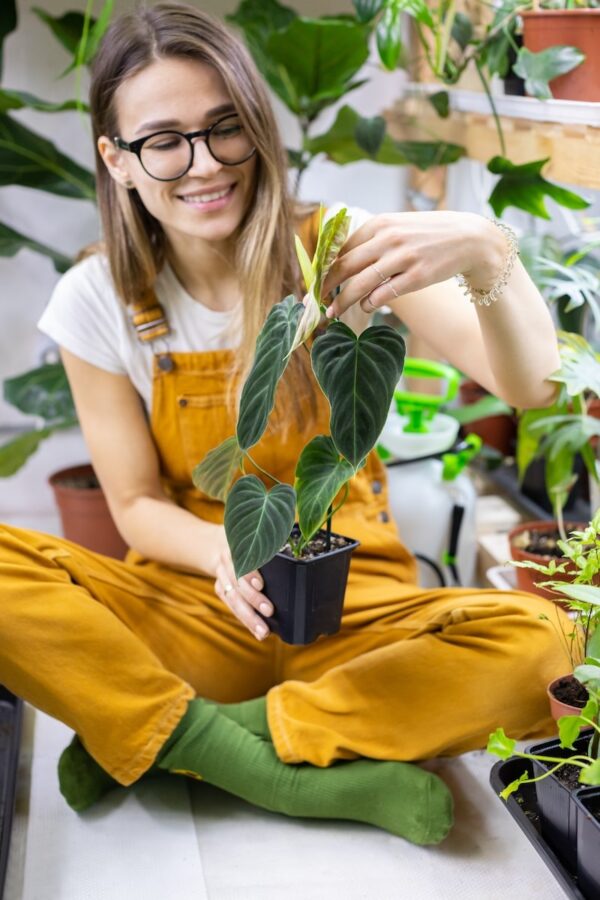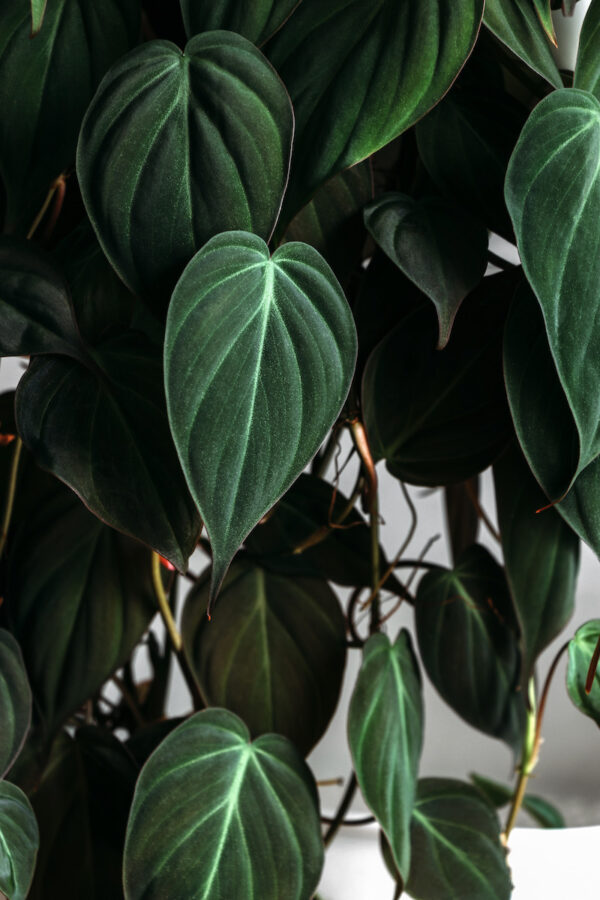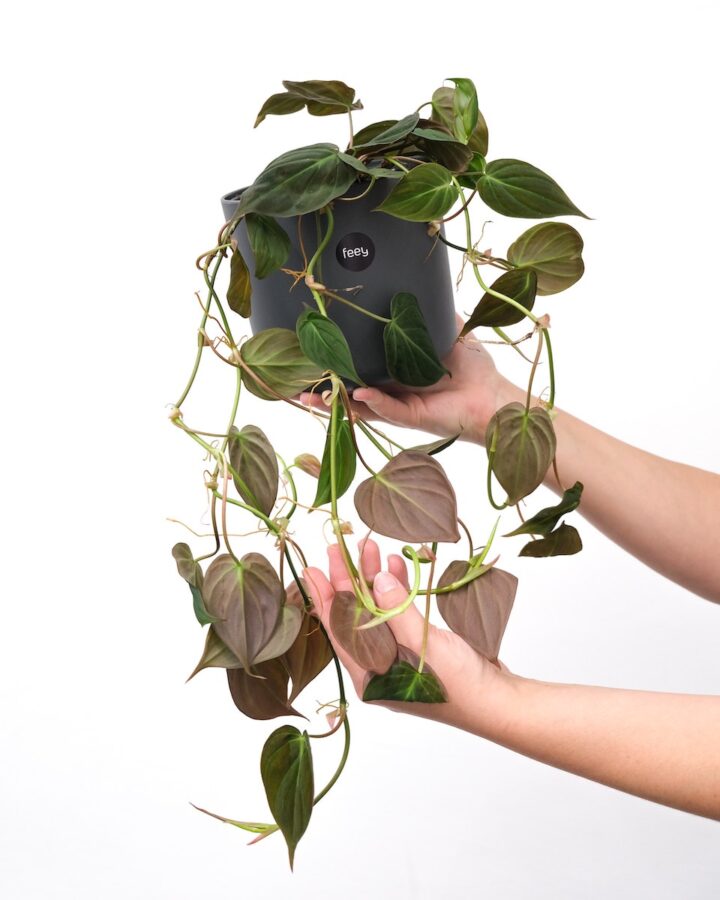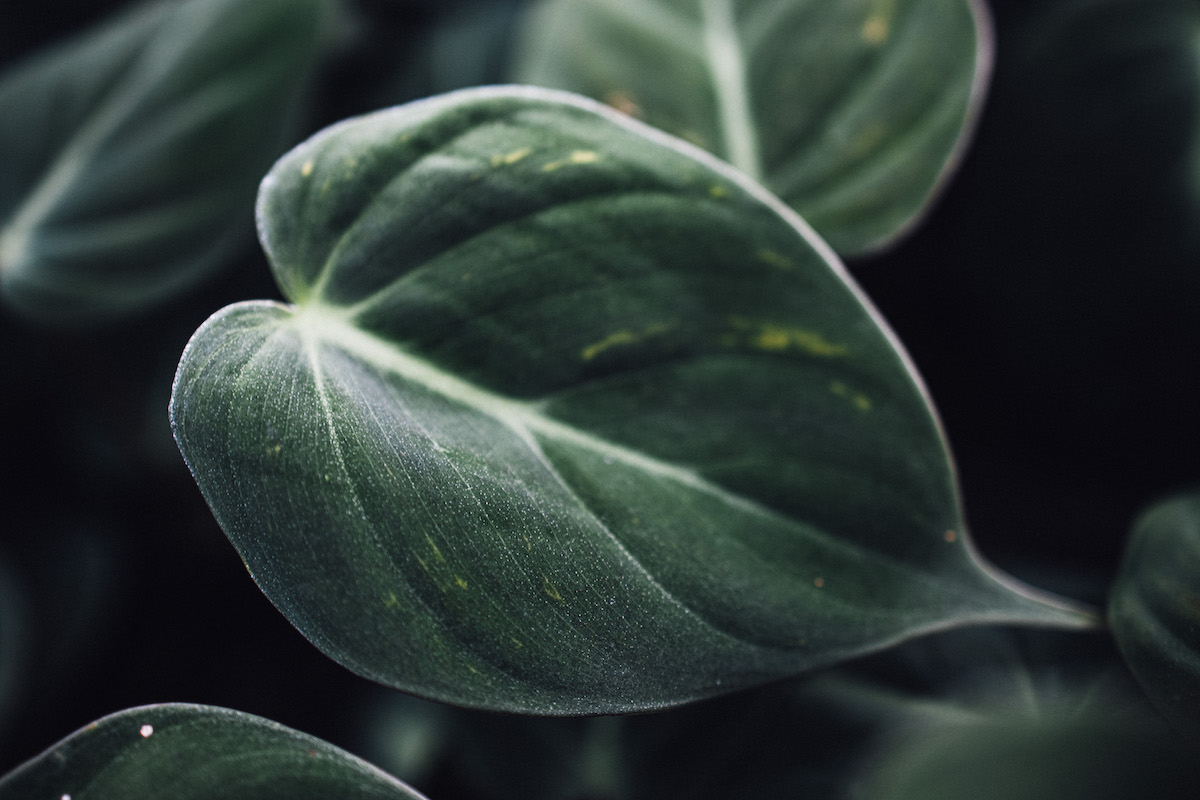The Philodendron is a trendy house plant that is doing rounds on social media. It’s highly sought after by amateurs and veterans alike due to its majestic looks and care-free maintenance.
The Philodendron Lupinum is another amazing variety of the Philodendron that is characterized by its heart-shaped velvety leaves fashioned with a maroon underside. This gorgeous climber will give your home a fresh look and feel.
Philodendrons have over 450 varieties; today, we’ll be discussing the famous Philodendron Lupinum.
Table of Contents
Meet the Philodendron Lupinum: Basic Knowledge and Origins
Philodendron is a large genus of plants from the Araceae family. They are native to South America and were first discovered back in 1644.
These gorgeous tropical plants are now popular house plants that people love keeping to enhance the aesthetics of their home, reduce stress, and cultivate positivity.
The Philodendron Lupinum is a unique variety that goes through quite the transformation. Juvenile Lupinums have small smooth leaves that grow 6-8 times their size as the plant matures. These huge leaves develop a velvety texture fashioned with a maroon underside that gives the plant its unique look.
It is also one of the easiest plants to care for – making it an amazing buy for beginners.
| Family Type | Araceae |
| Common Name | Philodendron Lupinum |
| Botanical Name | Philodendron vanninii Croat ined |
| Plant Type | Perennial and Shrubs |
| Size | Up to 20in leaves |
| Native Area | South America – North Brazil |
| Sun Exposure | Indirect sunlight |
| Soil Consistency | Loose, well-draining soil rich in organic matter |
| Soil pH | Mildly acidic (5.0-6.0) |
| Toxicity | Toxic to humans and animals |
| Common Pests | Aphids, scales, and mealybugs |
Varieties of Philodendron
It is estimated that there are about 400-500 known species of Philodendron. Listed below are some popular varieties of the Philodendron. These varieties vary based on their location, size, foliage, etcetera.
Philodendron Hederaceum
This highly adaptable variety of Philodendrons can thrive in almost all conditions. It’s an amazing plant for beginners, and it looks magnificent in hanging baskets. It is also called the Heartleaf Philodendron due to its small heart- leaves.
Philodendron Melanochrysum
Also known as the black gold philodendron, this plant has gorgeous leaves that sprout pink. Once matured, they turn into an elegant dark green with a bronze tint.
Philodendron Lemon Lime
As the name depicts, this variant has vibrant yellow and green foliage that brightens up its surroundings and makes for a great decoration piece.
Philodendron Domesticum
Also known as the elephant-ear philodendron, this variant is known for its huge leaves that can grow up to 2 feet tall. Its leaves resemble an elephant’s ear. It’s a great plant to have if you want to impress friends and family.
Philodendron Brandtianum
This variant has unique variegation on its leaves that almost make the leaves look like paintings. This variant will take your breath away with its stunning silver bands and striations that traverse throughout the leaves.
Philodendron Imperial Red
New leaves of the Philodendron Imperial Red appear to be deep red to maroon in color, which later mature to a darker green. This variety has a distinct, appealing rosette growth pattern.
How to Care for the Philodendron Lupinum

Sunlight
This majestic variety requires indirect sunlight for optimal growth and health. It typically thrives in medium-light environments.
However, this plant is extremely resilient and bodes well in low-light conditions as well. Placing it in a restroom would serve as a smart choice, thanks to high humidity and low to medium light conditions.
You just have to be careful about not letting your Philodendron sit in direct sunlight for too long as this could scorch the leaves.
Soil
The Philodendron Lupinum requires a well-draining aerated potting mix to thrive and reach its full potential. The most common potting mix is made up of equal parts perlite, orchid bark, and grower’s mix. This provides a balanced blend that is well-draining and adequately aerated due to the perlite.
Water
Philodendron Lupinum is an extremely resilient plant that can survive extended periods without water.
Even if you forget to water your Lupinum once or twice, it won’t harm the plant.
You need to water your Lupinum when the top half of the soil is dry to touch. The frequency of watering will vary with the conditions of its surroundings.
Water the Lupinum until drainage is established from the bottom holes, and get rid of any excess water. Make sure the soil doesn’t get too wet and soggy.
Temperature
Since Philodendron Lupinum is a tropical plant, it tends to do better in higher temperatures. A temperature between 12 and 27 degrees Celsius is ideal. Extended exposure below 12 degrees will cause the leaves to frost up.
Make sure your plant isn’t exposed to cold drafts that might damage the foliage.
Fertilizer
It is essential to fertilize your Philodendron Lupinum once a month during the spring and summer seasons.
You can dilute the fertilizer with some water and add it after you’ve watered your plant.
Calcium and magnesium are essential nutrients for your Philodendron so make sure to buy a fertilizer rich in these nutrients.
Potting
When potting the Philodendron Lupinum, it is important to remember that it needs a well-draining system. Hence choosing a pot that has suitable bottom drainage holes is paramount.
The best time to pot your Philodendron is in the spring season which will ensure optimal growth and health. Pot your plant in a well-draining mix and water it till drainage is established from the bottom holes.
You can select your pot depending upon whether you want it to climb or remain hanging from basket.
Re-potting
Philodendron Lupinum doesn’t require frequent re-potting. A good time to re-pot your Philodendron is when you feel like the roots have started to bulge out of the soil and drainage holes.
This means the plant has outgrown its current pot and needs to be shifted to a bigger pot.
The best time to re-pot your plant is in the spring.
Just transfer your plant to a bigger pot with fresh potting mix and water it adequately.
Leave it in a spot with favorable conditions so the roots can settle into the new pot.
Philodendron Lupinum needs re-potting once every year. This video is a great visual representation of how to properly re-pot your Philodendron.
Pruning

Pruning the Philodendron Lupinum is fairly simple.
Just pluck away the dead leaves shed around it and remove any yellowing leaves.
Use a sterile pair of scissors to cut away any extra growth growing around the base to shape your beloved plant and maintain its elegant presence.
Make sure you cut just above the leaf node to promote new growth. The best time to prune your plant is late spring or early summer.
Propagation
You can propagate your Philodendron Lupinum in several ways that are simple to execute. For optimal results, always propagate during the spring season and choose a healthy pest-free plant.
Stem Cuttings
The easiest way of propagating Philodendron is through stem cuttings.
Select a healthy pest-free plant for your cuttings.
Each cutting should have at least one leaf and one node. You can submerge your cutting in water or wrap it in sphagnum moss.
In a few weeks, small roots will start to form, and that’s when your cutting is ready to be planted in a new pot.
Thoroughly water your new cutting and place it in a favorable environment for optimal growth.
You can watch this informative video to better understand propagation.
Seeds
Propagation through seeds is a process that requires patience as it takes a longer time.
You can buy Philodendron seeds from your local plant store and submerge them in some soil.
Regularly water the seeds; they’ll germinate and sprout in about 2-8 weeks.
Let the freshly sprouted plants grow in the soil until you can transplant them into a new pot.
Air-layering
This method is a little technique-sensitive and complex compared to the other two.
Make a 45-degree slit halfway through a mature branch, and then wrap the freshly-cut slit with damp sphagnum moss.
Wrap plastic around the sphagnum moss to enclose the area and keep it in place.
In about 2 weeks, small roots will start to appear in the moss.
Separate this newly formed baby plant from the branch and plant it into a new pot.
Ensure the pot has fresh potting mix and is watered frequently.
Challenges & Solutions

Curled Leaf Tips
Your Philodendron might be experiencing curled leaf tips due to excess fertilization. To counter this problem, reduce the rate of fertilization and use slow-release fertilizers.
In severe cases, you might need to re-pot your Philodendron.
Yellow Smears on Leaves
Mosaic Virus infection presents as classic yellow stripes and imperfections.
To counter this infection, separate your affected Philodendron from the rest of the plants. Start by pruning off the affected leaves and then cleaning the rest of the foliage. The plant should start to recover on its own in a few weeks.
Yellowing Leaves
Yellowing of leaves can occur due to over-exposure to direct light or insufficient light. Make sure you place your Philodendron in a spot with adequate lighting to avoid this issue. The Philodendron Lupinum loves indirect light, so keeping it in a shady spot would suffice.
Browning Leaves
Leaves start to turn brown when the plant is overwatered. This is due to water-logged roots that prohibit the supply of nutrition to the leaves.
Counter this by re-evaluating the water needs of your plant and pruning away the affected leaves.
Only water your Philodendron when the top half of the soil is dry.
Brown leaves can also occur as a result of the natural aging process. Regularly prune your plant to get rid of the old leaves that start turning brown.
Bacterial Disease
Plants can easily get exposed to bacterial diseases if not cared for properly and left in unfavorable conditions. Some common bacterial infections your Philodendron Lupinum can face are;
Bacterial Blight:
Bacterial Blight is characterized by dark green spots on the leaves that tend to spread rapidly. Infected leaves start to rot and emit a foul odor.
Remove the diseased leaves and keep the rest of the foliage dry.
Bacterial Leaf Spot:
This infection is characterized by translucent lesions of random size and shape on the leaves.
Pests
Pests are every plant owner’s worst nightmare. They strip away your beloved leafy companion of its vibrancy and life. Some of the common pests that might infest your Philodendron Lupinum are;
Aphids
These notorious pests survive by feeding off the sap of the Philodendron Lupinum.
A good way to prevent infestation is to check your plant for aphids regularly. Spray your plant with diluted neem oil to eradicate these pests
Mealy Bugs
Mealy Bugs also feed on the sap of Philodendron. You can get rid of them by dabbing them with isopropyl soaked cotton.
If this doesn’t work, you can spray your plant with diluted neem oil or another stronger insecticide.
Scales
These resilient pests feed on the stems and nodes of your plant.
Their appearance resembles aerial roots, due to which they usually go unnoticed.
Scales can be extremely detrimental to your plant’s health, and they can only be removed physically by plucking them out.
Most sprays and chemical treatments are ineffective on scales.
Ask Away: the FAQ Section
When should I re-pot my Philodendron Lupinum?
You should re-pot your Lupinum when its roots start bulging out of its drainage holes. This means that your plant is now too big for your current pot.
It is best to re-pot during the spring season for optimal results.
Is Philodendron Lupinum safe to keep around pets?
The Philodendron Lupinum is highly poisonous and toxic for pets.
If your cat or dog has been biting on your plant, they might experience irritation, vomiting, and diarrhea.
Your pet might need medical assistance if they ingest a large amount of the plant.
Why are my Philodendrons leaves turning brown?
There can be one of two reasons for the leaves of your Philodendron to turn brown.
If the top leaves are turning brown, it’s because as the plant ages, the older leaves start turning brown. Just regularly prune your plant to prevent this.
The second reason is overwatering. To counter this you need to correct your watering schedule.
Only water your Philodendron Lupinum when the top half of the soil is dry to touch.

